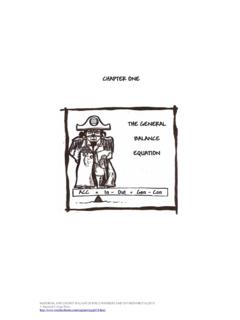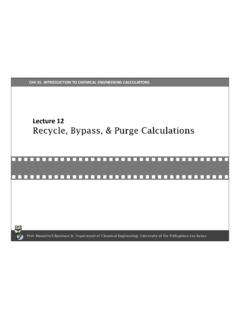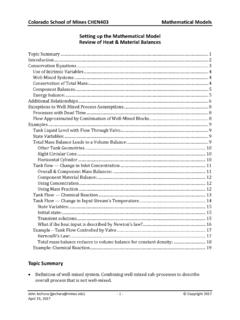Transcription of Chapter 9 Name: Balances on Reactive Processes Date:
1 Supplemental material for Elementary Principles of Chemical Processes Daniel L pez Gaxiola Student View Jason M. Keith Chapter 9 Name: _____ Balances on Reactive Processes Date: _____ Chapter 9 includes problems that involve material and energy Balances in Processes where chemical reactions are occurring. In addition, this Chapter will illustrate concepts related to Reactive Processes such as heat of formation, heat of combustion, exothermic and endothermic reactions, etc. The following sets of problem modules will apply the fundamentals on Reactive Processes to hydrogen technology and fuel cells. Calculation of Heats of Reaction Evaluation of r U Hess s Law Determination of a Heat of Reaction from Heats of Formation Calculation of a Heat of Reaction from Heats of Combustion energy balance on a Coal Gasification Process Calculation of Heat of Formation of Woody Biomass energy balance on an Adiabatic Reactor Simultaneous material and energy Balances Calculation of a Heating Value Calculation of an Adiabatic Flame Temperature Ignition Temperature and Flammability Limits Supplemental material for Elementary Principles of Chemical Processes Daniel L pez Gaxiola Student View Jason M.
2 Keith Example Calculation of Heats of Reaction a) A solid-oxide fuel cell is fed with carbon monoxide and reacts with air to produce CO2. This reaction will produce 2 electrons which are used to power an electric circuit external to the fuel cell. The reaction equation is shown below: 2CO(g) + O2(g) 2CO2(g) = This reaction does not occur for other types of fuel cells which use a catalyst, such as polymer-electrolyte membrane or phosphoric-acid fuel cells. The presence of carbon monoxide on the anode side of these types of fuel cells will cause catalyst poisoning, reducing the efficiency and voltage of the fuel cell. Determine the rate of enthalpy change for a carbon dioxide production rate of mol208hr. Strategy This problem can be solved by using the heat of reaction value given in the stoichiometric equation and calculating the extent of reaction.. Solution The extent of the reaction occurring in the fuel cell can be obtained by the following equation: rCOCO22(n)|| = where: rCO2(n) = molar flow rate of CO2 generated or consumed by the reaction.
3 CO2 = stoichiometric coefficient of CO2 in the chemical reaction equation. Substituting the numeric values of rCO2(n) and CO2 into the equation for the extent of reaction, we get: mol208hr2 = mol____hr = Supplemental material for Elementary Principles of Chemical Processes Daniel L pez Gaxiola Student View Jason M. Keith Now the rate of change in the enthalpy for the oxidation of carbon monoxide can be calculated as follows: orH H = Entering the known quantities for the extent of reaction and the enthalpy of reaction into this equation yields: molkJ1 s = H_____ kW = b) The synthesis gas obtained from a coal gasification process can be used for producing methanol, which is used as fuel in direct-methanol fuel cells. Determine the rate of production of methanol if the reaction shown below is releasing kW of energy . CO(g) + 2H2(g) CH3OH(l) = Strategy The enthalpy of reaction for methanol production will be used to calculate the production of methanol based on the extent of reaction.
4 Solution The extent of reaction definition used in part a) of this problem can be used to solve for the production of methanol as follows: rCH OHCH OH33(n)|| = rCH OHCH OH33(n)||= Now we have an equation to calculate the molar flow rate of methanol. However, the extent of reaction , must be calculated first. To do this, we will use the definition of the change in enthalpy for the chemical reaction: orH H = Supplemental material for Elementary Principles of Chemical Processes Daniel L pez Gaxiola Student View Jason M. Keith Solving for and substituting the corresponding quantities into this equation yields: orkJ_____Hmols === The rate in enthalpy change was considered to be negative since the problem is stating that the reaction is releasing energy (exothermic reaction). Now we can enter the calculated extent of reaction into the equation previously solved for the molar production rate of methanol, to get: ( )rCH OH3mol3600 s(n)_____1s1 hr = rCH OH3mol(n)_____hr= Supplemental material for Elementary Principles of Chemical Processes Daniel L pez Gaxiola Student View Jason M.
5 Keith Example Evaluation of r U a) The following reaction is occurring inside a solid-oxide fuel cell: 2CO(g) + O2(g) 2CO2(g) = Determine the standard internal energy of reaction, or U . Strategy The molar internal energy can be calculated by using its definition as a function of the stoichiometric coefficient of the gas species in the reaction. Solution The internal energy of reaction can be calculated by the following equation: rriigaseousgaseousreactan tsproducts U (T)H (T) RT|||| = This equation can be applied to the conditions in this problem to yield: ()oorrCOCOO22 UHRT || || || = Since we are asked to calculate the internal energy of reaction at standard conditions, the temperature will be 25 C. Substituting the known quantities into this equation, we get: ()orkJkJ (298 K) ___ 1 2molmol K = orkJ U_____mol = b) Direct-methanol fuel cells have application in portable devices such as mobile phones and laptop computers.
6 The following reaction between carbon monoxide and hydrogen is used to produce the fuel for this kind of fuel cells: CO(g) + 2H2(g) CH3OH(l) = Supplemental material for Elementary Principles of Chemical Processes Daniel L pez Gaxiola Student View Jason M. Keith Determine the standard internal energy of reaction, or U . Strategy To solve this problem, we will have to apply the internal energy of reaction definition to the chemical reaction equation. Solution This definition of the internal energy of reaction can be applied to the conditions in this problem to yield: ()oorrCOO2 UHRT|| || = Since the reaction is occurring at room temperature, the produced methanol is in the liquid phase. This is why the stoichiometric coefficient of methanol is neglected in this equation. Again, the temperature at standard conditions will be considered to be 25 C. By entering numeric values into the standard internal energy of reaction equation, we get: ()orkJkJ (298 K) ___ 2 1molmol K = orkJ U_____mol = Supplemental material for Elementary Principles of Chemical Processes Daniel L pez Gaxiola Student View Jason M.
7 Keith Example Hess s Law Hydrogen is a gas used as a fuel in different types of fuel cells, such as phosphoric acid, solid oxide and proton-exchange membrane fuel cells. This fuel can be obtained from natural gas through the following reactions: Steam-Methane Reforming: CH4(g) + H2O(g) CO(g) + 3H2(g) = Water-Gas Shift Reaction: CO(g) + H2O(g) CO2(g) + H2(g) = Determine the enthalpy of the following reaction by applying Hess s Law: 2CH4 + 3H2O CO + CO2 + 7H2 Strategy Hess s Law allows us to treat chemical reaction equations as algebraic equations. This way we can multiply the reactions by constants or add or subtract different chemical reactions. Solution The following reaction, does not occur directly, but it is a combination of the two reactions used to produce hydrogen from natural gas: 2CH4 + 3H2O CO + CO2 + 7H2 We can see that there are two molecules of methane. The only reaction in the hydrogen production process where methane is present is the steam-methane reaction.
8 In order to get two methane molecules, we can multiply the steam-methane reforming reaction by two to get: 2CH4 + 2H2O 2CO + 6H2 = It can be seen that as we multiply the equation by 2, the standard heat of reaction is also multiplied by 2. Another observation we can make from the equation we need to calculate the heat of reaction for is that there are 3 molecules of water reacting. This means we need to add or substract another reaction to the steam-methane reforming reaction in a way that there are 3 water molecules in the reactants. Thus, if we add the water-gas shift reaction to the steam-methane reforming reaction (multiplied by 2), we get: Supplemental material for Elementary Principles of Chemical Processes Daniel L pez Gaxiola Student View Jason M. Keith ( _____ + 2H2O 2CO + _____ ) + (CO + H2O CO2 + H2) 2CH4 + 3H2O + CO CO2 + 2CO + 7H2 If we look at this equation as an algebraic expression, one of the carbon monoxide molecules in the products will cancel with the carbon monoxide molecule in the reactants, to yield: 2CH4 + 3H2O CO2 + CO + 7H2 Now, this is the equation given in the problem statement.
9 To determine its heat of reaction, we will need to do the same algebraic operation with the individual heats of reaction: (2CH4 + 2H2O 2CO + 6H2) + (CO + H2O CO2 + H2) + Thus, the heat of the final reaction is found to be: orkJH_____mol = Supplemental material for Elementary Principles of Chemical Processes Daniel L pez Gaxiola Student View Jason M. Keith Example Determination of a Heat of Reaction from Heats of Formation Determine the standard heat of the methanol reaction taking place in a direct-methanol fuel cell to generate electricity: CH3OH(l) + 32O2(g) CO2(g) + 2H2O(g) Strategy The heat of a given reaction can be obtained based on the stoichiometric coefficient of the species involved in the chemical reaction and their individual heats of formation. Solution The heat of reaction can be calculated using the following equation: ooorif ,iif ,ireac tan tsproducts H|| H|| H = Applying this equation to the number of products and reactants for the reaction of methanol in the fuel cell yields: ooorCOOf ,COf ,O2222 H|| H_____ || H_____ + = Since an element is a pure chemical substance, there is no energy transfer involved in its formation.
10 Thus, the heat of reaction equation will be reduced to: oooorCOH OCH OHf ,COf ,H Of ,CH OH223223 H|| H|| H|| H + = The individual heats of formation for each one of these molecules can be found in Tables 2-220 (inorganic compounds) and 2-221 (organic compounds) of Perry s Chemical Engineers Handbook, 7th Edition. of ,CO2kJ = of ,H O2kJ H_____mol = of ,CH OH3kJ H_____mol = Supplemental material for Elementary Principles of Chemical Processes Daniel L pez Gaxiola Student View Jason M. Keith Substituting these values and the stoichiometric coefficients into the heat of reaction equation, we have: orkJkJkJ H( ___ ) (2) _____(1) _____molmolmol + = orkJ = Supplemental material for Elementary Principles of Chemical Processes Daniel L pez Gaxiola Student View Jason M. Keith Example Calculation of a Heat of Reaction from Heats of Combustion a) The following reaction is occurring in a steam-methane reforming plant to produce hydrogen fuel, which can be used in different types of proton-exchange membrane fuel cells.










